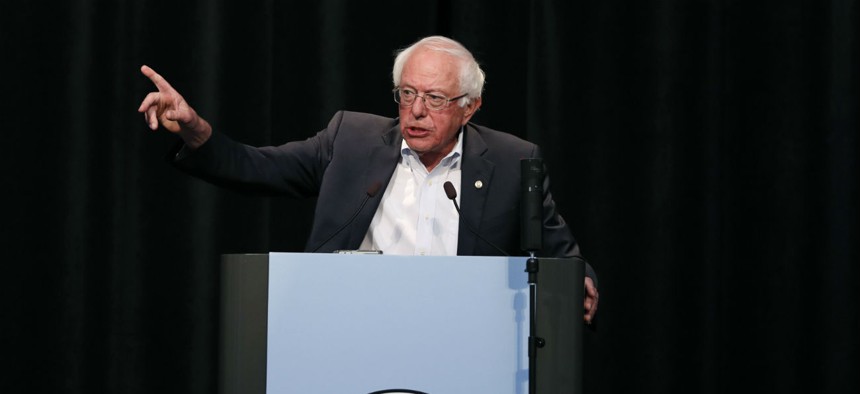
Democratic presidential candidate Sen. Bernie Sanders, I-Vt., speaks at the Iowa Federation of Labor convention on Wednesday. Charlie Neibergall/AP
Sanders Campaign Proposes Granting Feds the Right to Strike
Workforce, labor experts suggest there may be better ways to improve federal employees’s bargaining rights.
Democratic presidential candidate Sen. Bernie Sanders on Wednesday unveiled a comprehensive plan to restore the American labor movement following decades of declining union membership, and that plan includes a novel proposal for federal employee unions: granting them the right to strike.
Although federal employees have the right to unionize and bargain over working conditions, they long have been barred from engaging in one of the more potent tools in the labor movement’s playbook. The 1947 Taft-Hartley Act introduced a number of restrictions on strikes in both the public and private sectors, and banned federal employees from striking entirely.
Since that law’s enactment, efforts to push back on the ban have been rare. In 1981, the Professional Air Traffic Controllers Organization defied the law and declared a strike. Two days later, President Ronald Reagan fired more than 11,000 air traffic controllers who had ignored a federal court order to end the work stoppage.
Sanders’s plan would reverse that long-standing precedent; such a move would require Congress to pass legislation. In justifying the change, Sanders cited federal workers’ effective inability to protest orders to work without pay during the 35-day partial government shutdown in December 2018 and January 2019.
“Hundreds of thousands of [Transportation Security Administration] agents, air traffic controllers, [Internal Revenue Service] employees, members of the Coast Guard, and other federal government employees were forced to work without pay and without recourse,” the Sanders campaign wrote. “Under current law, the federal employees are not guaranteed the same labor rights as workers in the private sector. While they have the ability to unionize, they are prohibited from going on strike. Under this plan, federal workers would have the right to strike.”
Despite the ban on federal sector work stoppages, observers at the time speculated that steadily increasing numbers of unscheduled absences among the ranks of TSA screeners and air traffic controllers during the shutdown could have been part of a sickout, an informal partial strike.
But some labor experts suggested Sanders’s energy may be better spent on other areas where federal employee unions are hamstrung when compared with their private sector counterparts. Robert Tobias, director of business development for the Key Executive Leadership Program at American University and former president of the National Treasury Employees Union, pointed to the one issue that most feds are banned from bargaining over: compensation.
“If he were serious about providing additional opportunities to bargain in the federal sector, he could create a system similar to the U.S. Postal Service, where employees can bargain over pay and benefits, with interest arbitration as the final step in the process,” Tobias said. “I think that would be a feasible alternative, and would allow federal employees to catch up to the private sector.”
If effectively implemented, either on a departmental or bargaining unit-level basis, Tobias said such a deal might actually reduce the number of conflicts between labor and management, and force officials to focus on agency stewardship and policy implementation, rather than just policymaking.
“Most secretaries of departments who come to the federal sector are private sector people with little understanding of federal labor-management relations, because they don’t have it in their own companies,” Tobias said. “And they’re political appointees, so they have short terms [in office] and they don’t focus on creating long-term relationships because it’s time away from policy creation . . . But if you added not only the personnel policies but also the pay and benefits, that could focus a secretary’s attention not only on policy creation, but on implementation in a real way.”
Donald Kettl, academic director of the University of Texas at Austin’s Lyndon B. Johnson School of Public Affairs, noted that while much of Sanders’s plan is aimed at increasing the number of unionized workplaces, the federal government is actually an outlier in that regard, despite federal unions’s diminished bargaining rights. And strikes generally depend on solidarity within an entire bargaining unit, but in the federal government, union membership is strictly voluntary.
“It’s worth noting that the strike has, in general, become a much less used weapon because far fewer members of the workforce are union members,” Kettl said. “Moreover, union membership in the public sector is five times higher than in the private sector.”
The Sanders campaign did not respond to a request for comment.
NEXT STORY: North Carolina Sheriffs Win a Round Against ICE







